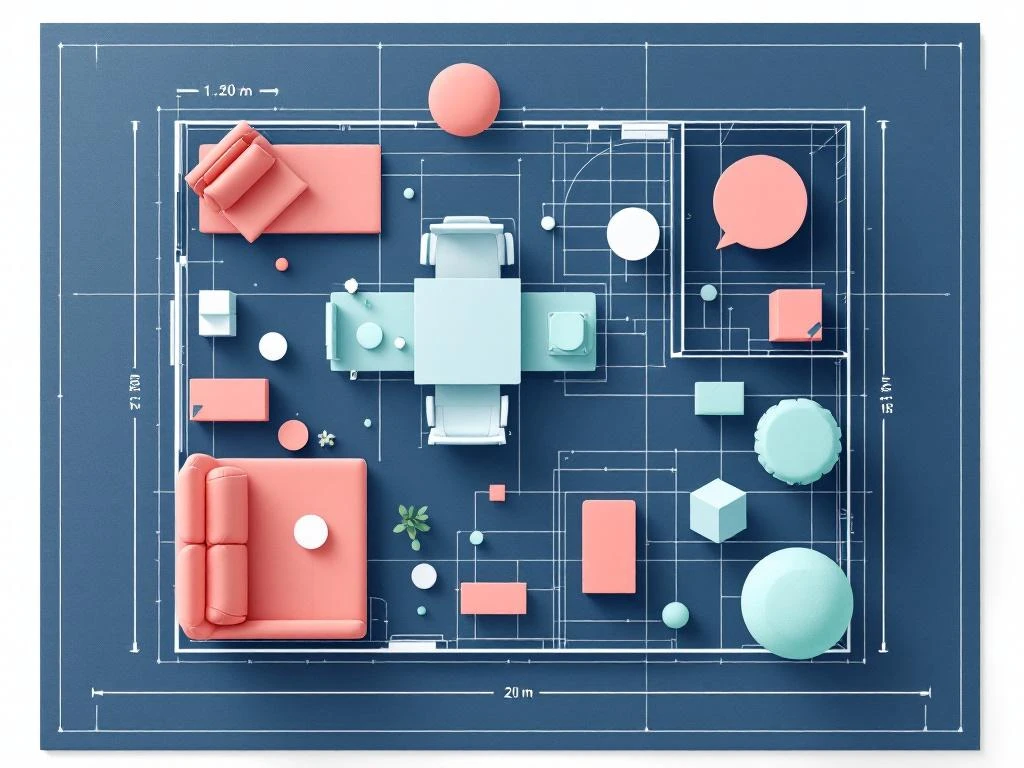The cost of office design per square meter varies greatly depending on your needs and budget. For a basic interior, you can expect to invest between €150 and €300 per square meter, while a standard office interior usually costs between €300 and €500 per square meter. Premium offices with high-quality furniture and finishes can reach €500-1000+ per m2. These prices include desks, chairs, storage and basic lighting, but exclude additional costs such as installation and ICT infrastructure.
What does the average office design cost per m2 in the Netherlands?
In the Netherlands, you can divide the cost of office furnishings into three main categories. The base category (€150-300 per m2) offers functional furniture that is fine for start-ups or temporary office spaces. For this, you get simple desks, standard office chairs and basic storage solutions.
The standard category (€300-500 per m2) is what most Dutch companies choose. This investment gets you high-quality office furniture that will last for years, ergonomic chairs and well thought-out storage solutions. This price segment offers the best balance between quality and cost.
For premium office design (€500-1000+ per m2), you get designer furniture from top brands, fully adjustable workstations and luxury finishes. This category is popular with law firms, consulting firms and companies looking to impress clients.
Several factors influence these prices. The location of your office plays a role - in large cities such as Amsterdam, suppliers tend to be more expensive. The quality of the materials chosen, the complexity of the installation and the supplier chosen also affect the final price. At the rent office space you can sometimes take advantage of inexpensive packages that already include the furnishings.
What components determine the cost of office design?
The total cost of office design consists of several components, each with its own percentage of the total budget. Desks and workstations are usually the biggest expense, accounting for 30-40% of your total furnishing budget. This includes not only the desks themselves, but also associated dynamics such as cable trays and desk screens.
Chairs take up 15-20% of your budget. This may seem like a lot, but good office chairs are important for your employees' health and productivity. Saving on chairs can lead to higher costs later due to sick leave.
Storage solutions such as cabinets, drawer units and filing cabinets make up 10-15% of the cost. Lighting, often underrated but very important for a pleasant working atmosphere, also costs about 10-15% of your budget. Consider ceiling lights, desk lamps and mood lighting.
IT infrastructure takes up 15-20% of your budget. This includes cabling, outlets, network connections and any server rooms. The remaining 5-10% goes to decoration and other items such as plants, art on the wall and coffee facilities.
These proportions may vary by office type. A creative agency may invest more in inspiring decoration, while an IT firm spends a larger portion of its budget on IT infrastructure.
How much does a basic workplace setup cost?
To furnish one complete workspace, you should expect an investment between €650 and €2,350, depending on the quality you are aiming for. A good agency costs between €200 and €800. For €200 you get a simple, fixed desk, while for €800 you can buy an electrically adjustable desk with memory function.
An office chair is an investment between €150 and €600. At the lower end of this spectrum, you'll find basic chairs with limited adjustment options. For €600 you get a fully ergonomic chair with all possible settings and a long warranty.
Lighting for one workstation costs €50 to €200. This usually includes a desk lamp and possibly additional ceiling lights. Storage such as a drawer unit or small cabinet costs €100 to €400 per workstation.
Accessories such as a keyboard tray, monitor arm, mouse pad and desk organizer together cost €50 to €150. The difference between a home office desk and a professional office desk is mainly in the quality and durability. Home furniture is often cheaper but less suitable for intensive daily use.
What is the difference in cost between new and used office furniture?
Used office furniture can save you 40-70% over new. A desk that costs €600 new can often be found second-hand for €200-350. This significant saving makes used furniture attractive to start-ups or businesses with limited budgets.
The benefits of secondhand go beyond price. You can often purchase high-quality brand-name furniture for the price of new budget furniture. Plus, it's more sustainable to give existing furniture a second life.
There are drawbacks, too. Choice is more limited, and you sometimes have to make concessions on color or model. Warranties are usually short or absent, and some parts may wear out. Office chairs require extra care - the gas spring and upholstery may need replacement after years of use.
For the best balance, consider a mix. Buy desks and cabinets secondhand, but invest in new chairs and IT equipment. That way you combine cost savings with comfort and reliability where it counts.
How do you calculate the budget for different office spaces?
Calculating your furnishing budget begins with determining the types of spaces in your office. For open-plan offices charge €200-400 per m2. These spaces can be set up efficiently because you can cluster workstations and share facilities.
Private offices cost more: €300-600 per m2. Each room has its own lighting, climate control and often more luxurious finishes. Meeting rooms are the most expensive at €400-800 per m2 because of specialized furnishings such as presentation screens, conference tables and acoustic facilities.
Reception areas cost €250-500 per m2. Here you invest in presentable furniture and an inviting atmosphere. Let's do some sample calculations:
For a 50m2 office with mostly open workspace (40m2) and a small meeting room (10m2), you come out to: (40 x €300) + (10 x €600) = €18,000 for a standard interior.
A 100m2 office with 70m2 of open space, 20m2 of private offices and 10m2 of reception will cost approximately: (70 x €300) + (20 x €450) + (10 x €375) = €33,750.
For a large 200m2 office with several rooms, you can expect an investment from €60,000 for standard furnishings to €150,000 for premium.
What additional costs are involved in office design?
In addition to the furniture itself, there are several additional costs what to consider. Transportation and assembly usually make up 5-15% of your total furniture budget. Professional assembly is recommended especially for complex systems to avoid damage and loss of warranty.
Project management costs 3-8% extra but can save you a lot of time and stress. A project manager coordinates deliveries, monitors schedules and solves problems. On larger projects, this is almost indispensable.
Adjustments to electricity and ICT cost €50-150 per m2. This includes extra sockets, data cabling and any modifications to the meter box. Modern offices need many more connections than older buildings offer as standard.
Flooring costs €30-100 per m2, depending on your choice of carpet tiles, PVC or other materials. Also don't forget about any remodeling costs such as installing partitions, painting or adjusting lighting. These costs can vary widely but for a completely new office, make a reservation of 20-30% on top of your furniture budget.
How can you save on office furnishing costs without losing quality?
Smart purchasing can save you thousands of dollars without compromising on quality. Bulk purchases often yield discounts of 10-25%. Always ask about volume discounts, even for smaller quantities.
Timing is important. Suppliers often have seasonal sales, usually in January and July. That's when they make room for new collections and you can score top-quality furniture at a deep discount. Showroom models are also interesting - these are often barely used but significantly cheaper.
A mix of new and used is a smart strategy. Buy items that get a lot of wear and tear new (chairs, keyboards) and less-used items second-hand (cabinets, conference tables). Modular systems are more expensive initially but save in the long run because you can modify and expand them without replacing everything.
Phased purchasing not only spreads the cost but also gives you a chance to learn what works and what doesn't. Start with the essential workstations and expand gradually. Always negotiate price, especially for larger orders. Ask about package pricing, free delivery or extended warranty.
Choose timeless designs in neutral colors. These not only last longer in terms of style, but are also easier to resell or add to. Trends come and go, but classic office furniture will always remain functional and presentable.
What is the cost of ergonomic office design?
Ergonomic office design costs more than standard furniture, but the health benefits far outweigh the additional cost. Adjustable desks cost €200-500 more than fixed desks. An electrically adjustable desk starts around €450, while top models with memory function and collision protection cost €1000+.
Ergonomic chairs are €150-400 more expensive than basic models. For €300 you already get a decent ergonomic chair, but for people with back problems or long working days it pays to invest €600-800 in a top model with all the adjustment options.
Monitor arms cost $50-150 each but are valuable for good work posture. They free up desk space and position the screen at the correct height. Other ergonomic aids such as wrist rests (€15-30), foot rests (€30-80) and document holders (€20-50) are relatively small investments with big impact.
The additional cost for fully ergonomic furniture is approximately 30-50% over standard. This investment pays for itself through reduced absenteeism, higher productivity and improved employee satisfaction. Many companies see a decrease in physical complaints of 40-60% after implementing ergonomic workstations.
How much should you set aside for maintenance and replacement?
For maintenance and replacement, you should annually 5-10% of the acquisition value reserve. This seems like a lot, but it prevents you from suddenly facing large expenses. So an office with €50,000 worth of furniture reserves €2,500-5,000 per year.
The lifespan of office furniture varies greatly from item to item. Desks last 10-15 years with normal use, high-end models even 20 years. Office chairs have a shorter lifespan of 5-10 years, depending on intensity of use and quality. The upholstery and gas spring usually need replacement first.
Cabinets and storage systems are the most durable with a lifespan of 15-20 years or longer. Only moving parts such as drawers may require earlier maintenance. IT equipment has the shortest lifespan: computers and screens are usually replaced after 3-5 years.
Plan replacements strategically. Don't replace everything at once but spread expenses over several years. Keep an inventory list with purchase date and expected replacement date. That way you won't have any surprises and you can take advantage of favorable offers when they arise.
Conclusion: investing smartly in your office design
Furnishing an office requires a significant investment, ranging from €150 to €1000+ per m2. The main cost factors are the choice between basic, standard or premium quality, the distribution among different room types and the balance between new and second-hand.
Smart savings can be made by purchasing in phases, negotiating bulk discounts and choosing a thoughtful mix of new and used. Remember to budget for ancillary costs such as transportation, installation and IT modifications - these can mean 20-30% on top of your furniture budget.
Balancing budget, quality and employee satisfaction is important. Investing in ergonomic solutions costs more but pays off in healthier and more productive employees. Plan ahead, too: set aside 5-10% annually for maintenance and replacement.
For companies seeking flexibility or not wanting to make large investments, we at Co-Office offer an interesting alternative. Our fully furnished workspaces in Amsterdam, for example, eliminate the need for large initial investments. You pay a fixed monthly fee and can start working immediately in a professional environment. Curious about the possibilities? Then take contact with us for a no-obligation discussion about your ideal workplace.

